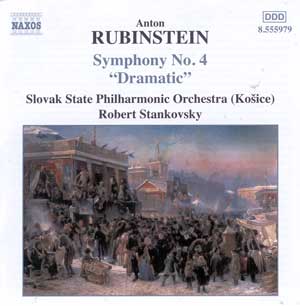The Fourth is probably the best of Rubinstein’s Symphonies.
Written in 1874 it’s a deeply uneven and ultimately unconvincing work
but contains enough perplexing turbulence to elevate it far beyond the
merely decorative, beyond the post Mendelssohnian symphonic statement.
If it never reaches the heights of a genuine Romantic crisis symphony
it contains intriguing material sufficient to warrant more than a second
hearing and this Naxos issue, first issued on Marco Polo 8.223319 in 1991,
provides just such an opportunity.
The First Movement opens with angular and forbidding
string writing. A more exultant theme enters followed soon by a compelling
species of orchestral winding-down before an explosion in a unison string
outburst of genuine outpouring – a moment of deeply remarkable writing
and one that seems to strain the symphonic form in which it is housed.
Striving and eloquent strings follow, over a dancing pizzicato, as Rubinstein
tries out his theme in differing orchestral colours and guises. Certainly
the thematic material is over-repeated and it’s also somewhat underwhelming
in its melodic presumptions but there are some marvelous touches – at
17’50 for example where the delicacy of the string writing shades into
solos for flute, clarinet and bassoon. The conclusion of the movement
reveals a little orchestral untidiness from the otherwise well-equipped
Slovak Orchestra. The Presto contains some very oppositional writing
though nothing as volcanic as the earlier movement. From stern unison
string writing and mellow winds some jovial violin figures lead onwards
to lashing animation and a melody of decisive force – the solo violin
passage over ostinato basses adding another voice to the rich orchestral
patina. Some of this is rather reminiscent of Raff and early Dvořák.
The Adagio is a freely moving slow movement in which
strings and wind vie for dominance. The long string melody – attractive
and persuasive – is later enlivened by exchanges between flutes and
the warmth of the divided string section. The finale picks up the quivering
angularities of the opening movement. Its turbulence is a classical
mirror of the First Movement’s divergences and disjunctions. Piccolo
is prominent, fractious brass increasingly so; a sturdy second theme,
in F Major, and a wind episode are both of charming vivacity and impel
the conclusion, which is both colourful and confidently triumphant.
A decade on the Slovak State Philharmonic performance holds up well;
some imprecision, a lack of string heft sometimes. But Stankovsky has
a good sense of the trajectory of Rubinstein’s imaginative writing and
guides us well and resolutely. There is at least one rival – Russian
Disc RDCD 11357 with the Russian State Symphony Orchestra conducted
by Igor Golovchin and released in 1995, which I’ve not heard. But Stankovsky’s
is a welcome return to the catalogue at budget price and heartily recommended.
Jonathan Woolf


